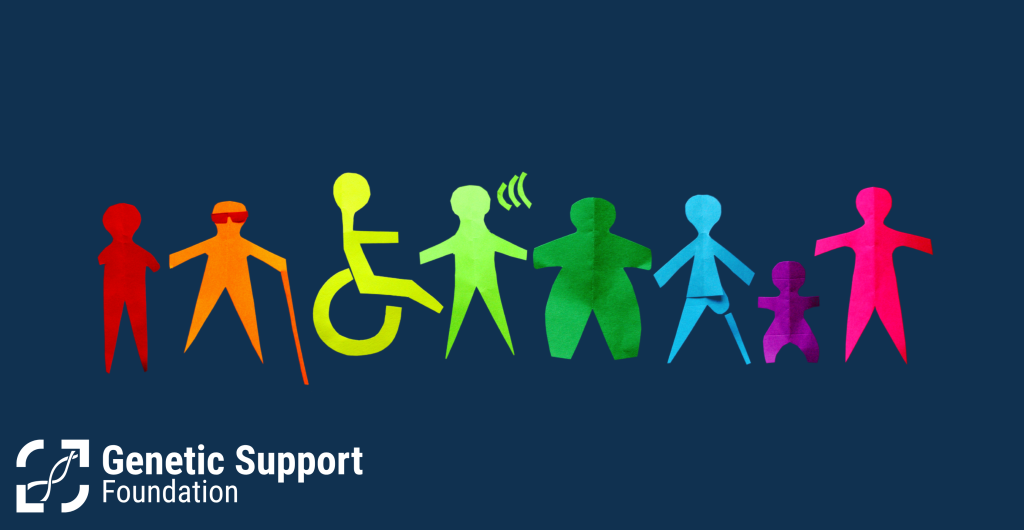By Devin Shuman, CGC (she/her) and Andrea Schelhaas, CGC (she/her)
*Of note, we purposefully use capital D in Disabled and capital A in Autistic in this text as individuals who embrace disability as a core part of our identities and who are part of the larger Disability community advocating for disability rights and equality.
Today, we have a short question with a long, complicated answer for you to ponder. What is health? And, just as importantly, who gets to define it?
The World Health Organization defines health as “a state of complete physical, mental and social well-being and not merely the absence of disease or infirmity.” However, this definition raises further questions – what is “a state of complete well-being?” What does it look like? Who defines what it means to be “well”? How does “well-being” differ from the very term it is meant to describe? Instead, this definition of health becomes circular and ultimately useless.
Working in prenatal and pediatric genetics, we often hear parents state that they “just want a healthy child.” The sentiment comes from a place of love and good intent. When asked to elaborate on what they mean by “healthy,” parents often reference an absence of pain or hardship, the ability to achieve, and a life without barriers to their child’s hopes and dreams. In essence, parents are searching for some level of certainty or belief that their child will live a “full, successful life.” However, these ideals are not easily defined or achieved.
No life is free from pain, hardship, or barriers to one’s hopes, dreams, and “achievements,” regardless of how these concepts are defined. Even when we solely focus on medical diagnoses, disability is common. In the US, approximately 10% of children experience a speech delay, 10% are diagnosed with ADHD, 1-10% live with epilepsy or seizures, 3% are Autistic, and 3% are born with a birth defect (such as the 1% of babies born with a heart defect). In adulthood, 15% of individuals develop type 2 diabetes, 50% experience high blood pressure, 5% have coronary artery disease, 20% live with anxiety, and 40% face a cancer diagnosis during their lifetime. For example, disability is often framed as the opposite of health and well-being, yet it is the one “minority group” that everyone, if they live long enough, will join.
Even “rare” diseases, when considered collectively, are not that rare. Who is this “healthy general population” we so often use as a benchmark? Why is average defined as “healthy” instead of just “a common state of being?” And why are those who fall outside the center of a bell curve considered “impaired,” “abnormal,” or “defective?” For decades, the Disability community has long advocated for a shift in this narrative, shouting that we are not “broken” – we are simply representing the full spectrum of human existence.
How did we get here and where do we go?
The concept of being “healthy” is often positioned as the opposite of having a health condition or medical diagnosis, but again – who defines “normal health?” Historically, “norms” of health or wellness were established through limited studies focused primarily on white, upper-middle class, cis-gender, and heterosexual individuals assigned male at birth. Entire populations, particularly individuals assigned female at birth, historically marginalized ethnicities, and gender-diverse communities, were systematically excluded. In many cases, so-called health “norms” were either shaped by pharmaceutical companies to pathologize human differences for profit or co-opted from benign origins and repurposed as tools of exclusion. For example, IQ was developed as a measure to identify students who had different learning needs but has been weaponized to justify eugenics, forced sterilizations, and restrictive immigration policies. We still use measures like IQ to define and compare what is “normal” and what is “deficient” or “other,” reinforcing outdated and exclusionary standards.
Centering “health” as the ideal for all causes great harm. It stigmatizes Disabled people for existing in their minds and bodies as they are. It isolates Disabled students for being “problematic” just because they exist in an educational system that is designed to support able-bodied, neurotypical individuals, not one that is prepared to support a full range of learners. Instead, there is a notion that individuals who do not hear, see, speak, think, act, or move like the statistical majority are a problem that needs to be fixed. We idealize “health,” not because it is universally attainable, but because it helps to distance ourselves from the reality that we have created a society that does not support everyone. Labeling some as “less than” makes it easier to ignore systems that are not inclusive.
There is no default human body, mind, experience, or existence. The next time someone references “being healthy,” ask yourself – What do they really mean by that? Where did those “accepted norms” originate from and what purpose do those really serve in this context? Who benefits from them and who is harmed? The definition of health as “a state of complete physical, mental and social well-being” is dangerously generalized, stereotyped, and an unachievable concept that ignores the complexities, individual nuances, and biases that shape our understanding of health. This obsession with complete well-being leads us to ignore the structural causes of harm including inaccessible environments, discriminatory policies, and ableist assumptions. In chasing this ideal, we exclude most Disabled people, and, truly, most people entirely.
So once more, we ask: Who defines “health?” And, most importantly, how does this concept shape our society when chasing an ideal of “complete well-being” excludes the vast majority of people?

